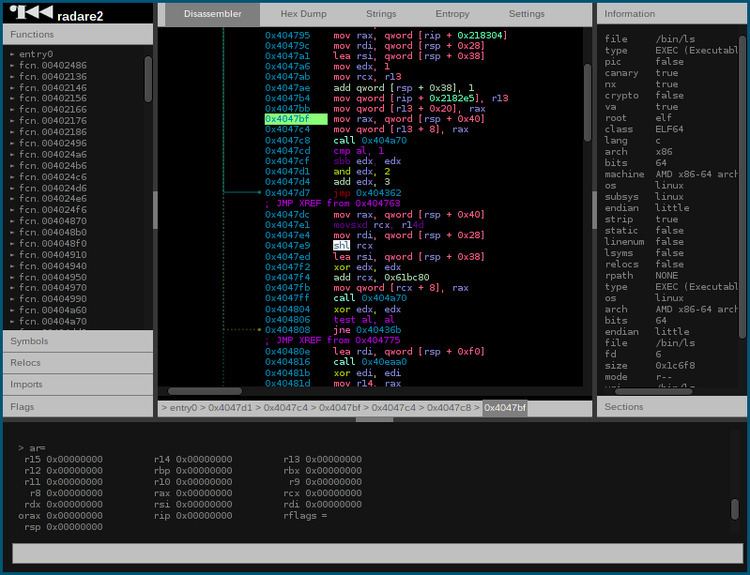Development status Active | Written in C | |
 | ||
Original author(s) Developer(s) pancake and the core-contributors Stable release 1.0.2 / November 10, 2016; 4 months ago (2016-11-10) Repository github.com/radare/radare2 | ||
Radare2 (also known as r2) is a complete framework for reverse-engineering and analyzing binaries; composed of a set of small utilities that can be used together or independently from the command line. Built around a disassembler for computer software which generates assembly language source code from machine-executable code, it supports a variety of executable formats for different processors and operating systems.
Contents
History
It was created in February 2006, aiming to provide a free and simple command line interface for a hexadecimal editor supporting 64 bit offsets to make searches and recovering data from hard-disks, for forensic purposes. Since then, the project has grown with the aim changed to provide a complete framework for analyzing binaries while adhering to several principles of the Unix philosophy.
In 2009, the decision was made to completely rewrite it, to get around limitations in the initial design. Since then, the project continued to grow, and attracted several resident developers.
In 2016, the first r2con took place in Barcelona, gathering more than 100 participants, featuring various talks about various features and improvements of the framework.
Since a couple of years, radare2 was presented at several high-profile security conferences, like the recon, hack.lu, 33c3, …
Features and usage
Since it doesn't have a GUI, it has a steep learning curve. Originally built around a hexadecimal editor, it has now a multitude of tools and features, and also bindings for several languages.
Static analysis
Radare2 is able to assemble and disassemble a lot of things, but it can also perform binary diffing with graphs, extract information like relocations symbols, and various other types of data. Internally, it uses a NoSQL database named sdb to keep track of analysis information that can be inferred by radare2 or manually added by the user. Since it is able to deal with malformed binaries, it has also been used by software security researchers for analysis purposes
Dynamic analysis
Radare2 has a built-in debugger, that is lower-level than the classic GDB. However, it can also interface itself with the GNU debugger, or even WineDBG to debug Windows binaries on other systems. It is even possible to use it as a kernel-debugger with VMWare. Also there is a support for the WinDBG protocol.
Software exploitation
Since it features a disassembler and a low-level debugger, radare2 can be useful to developers of exploits. The software has features which assist in exploit development, such as a ROP gadget search engine and mitigation detection. Because of the software's flexibility and support for many file formats, it is often used by capture the flag teams and other security-oriented personnel. Radare2 can also assist in creating shellcodes with its 'ragg2' tool, similar to metasploit.
